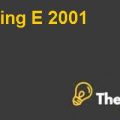Royal Mail plc: Cost of Capital Case Study Help
Cost of Capital Estimate Detailed by Kyle Brooks in Exhibit 6
The cost of capital estimation is wrong which was detailed by Kyle Brooks in Exhibit 6 provided in the case due to many reasons. Referring to Exhibit 6, the cost of equity was estimated with the use of the current dividend yield for the company. It is pertinent to note that the dividend yield does not take into consideration the expected appreciation of the stock price or in dividends, due to which Brooks should have used an approach of security market line which could estimate the expected return on equity of Royal Mail Plc. The reason is that the SML approach could be applied to companies other than those with steady growth in dividends. Additionally, a 10-year government bond yield i.e. 2.03% should be used as a risk-free rate of return due to the reason that the 5-year government bond yield is short term bond and does not embed the expectation of inflation of long term debt. Furthermore, a beta estimate of 0.65 used by Brooks in his estimations. A value that is below zero would tend to be more consistent with the expectation of the risk profile of Royal Mail Plc Company. Hence, the 0.65 beta seems comparable to the comparable firm estimates in Exhibit 9 of the case. With the new estimates, the new cost of equity is calculated to be 2.067%.
On the other hand, for the cost of debt, the coupon rate is equivalent to the pre-tax cost of debt. But, the interest expense that was paid by the company as a cost of debt was used by Brooks. The approach is incorrect because it does not take into account the prevailing market conditions quite relevant for the investors of the company. He could have used the better approach that is to estimate what its investors require on the basis of the prevailing rates. He could have used the prevailing bond yields of similar credit ratings. In accordance with exhibit 6, the current credit rating of Royal Mail Plc is BBB which means that the company has adequate capacity to paythe principal amount and interest payments.
Moreover, to weigh the equity and debt, Brooks used book values (in millions of GBP) which is not correct. Brooks should have used market value rather than book value due to the fact that the company is highly concerned with the estimation of how much it would cost to Royal Mail raise the finance today. This value is by the market value of capital of the company not its accounting or book value. From the correct assumptions, the weighted average cost of capital is calculated to be 5.4 percent. Thecalculation can be seen in Appendix C.
Principles for Cost of Capital Estimation
Some principles should keep in mind while estimating the cost of capital of the company such as; the cost of capital is not set by managers of the company but the market itself. Also, the cost of capital tends to reflect the effects of the after-tax in the policy of financing. When the company hasan interest, there would be tax shied, which demonstrates that the firm could lower the tax liability by borrowing an amount of debt. When considering the investment, the cost of capital tends to concern with the current market values over the historical book values. To calculate the cost of opportunity of the total capital of business, a weighted average of required return values are used for the various types of investorsincluding debt holders and equityholders. Furthermore, the cost of capital most likely reflects the capital structure of the company to the risk of the underlying cash flows for the period (Kenneth Eades, 2018)
Conclusion
Royal Mail Plc isa provider of national postal service which is responsible for mail delivery and collection in the UK. It is an international business, developing an efficient, modern and optimized network to deliver new products, parcels, and letters. Due to the deregulation and privatization, the cost of capital became an issue within an organization. The cost of capital estimation which was detailed by Kyle Brooks is wrong because of many unproven concepts. With the use of appropriate assumptions, the new cost of capital of the company is calculated to be 5.4%................................
This is just a sample partical work. Please place the order on the website to get your own originally done case solution.











